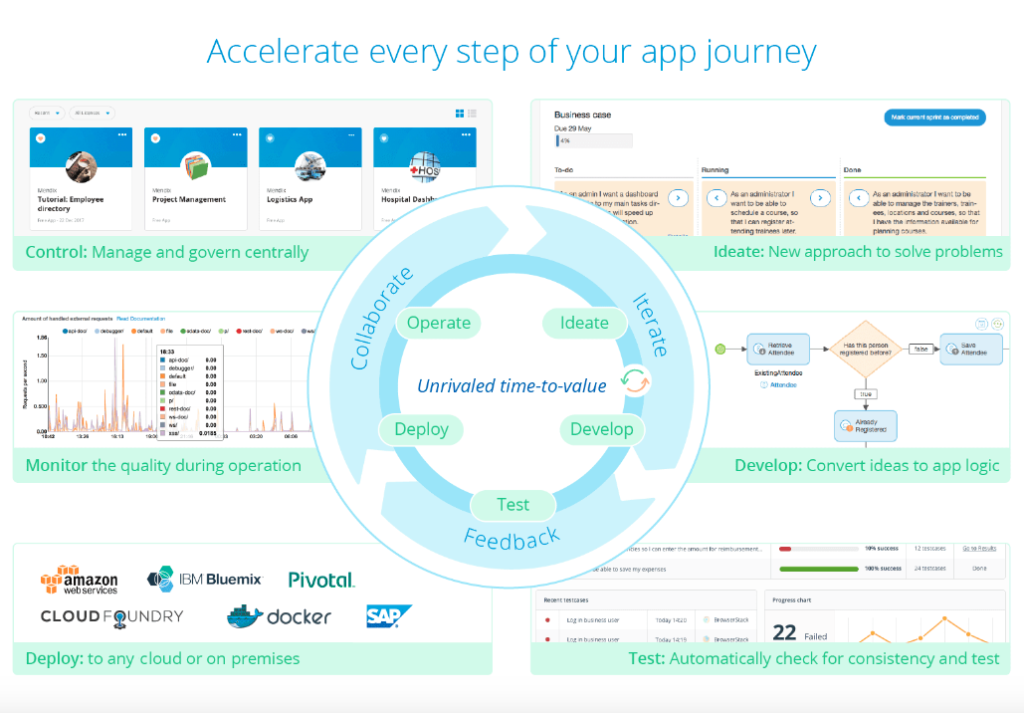1. Introduction
The interest in Low-Code development platforms has spiked in the last few years and the amount of information available is overwhelming. So how should you know if it is something useful to you and your company, and should you consider using it as you move forward? These are the questions we hope to answer for you in the following blog as we explore the various applications and benefits of this technology. This blog is targeted at heads of companies that are looking to integrate Low-Code technology into their firm, developers who want to learn more about why companies should explore Low-Code, and anyone who has an interest in expanding their understanding of Low-Code.
2. What Is Low-Code?
Before we go into its specific advantages, let’s first summarize briefly what Low-Code is.
Low-Code, as the name suggests, is a form of technology that relies less heavily on manual code inputs than traditional development techniques. Employing a graphical user interface and a drag-and-drop methodology, Low-Code platforms create software by using pre-existing code sets as building blocks for its core. From there, additional code can be overlaid and then customized to the extent of your choice and ability. Low-Code development platforms allow you to ignore the underlying complexity of the code and are thus accessible to a greater variety of technical experience levels.
There are a lot of Low-Code platforms options available. At Kyanon Digital we focus on Mendix for our activities, the Low-Code platform created by Siemens. Identified as a leader in the industry by Gartner’s Magic Quadrant, Mendix is a cloud based Low-Code platform that focuses on a range of multi experience applications. It assists designers and developers while focusing on IoT and Digital Twin use.
All Low-Code platforms accelerate your building process, but some, like Mendix, go so far as to enable you to streamline development and make personalized, adaptable modern enterprise applications. These applications drive new levels of innovation and digital transformation throughout your organization, allowing you to integrate from any data source and differentiating your organization from your competition.
The visual approach of Low-Code technology “optimizes the entire development process to accelerate delivery. With low-code, you can abstract and automate every step of the application lifecycle to streamline the deployment of a variety of solutions” according to Mendix, a leading low-code development platform in the Gartner Low-code Magic Quadrant 2022.

Transform your ideas into reality with our services. Get started today!
Our team will contact you within 24 hours.
3. Top 5 Reasons To Use Low-Code Development
3.1 Flexibility

Flexibility is a key component of Low-Code. With its architecture relying on core components with customizable additions, it retains the capacity to extend legacy systems without limitations. Being open and extensible at every level, Low-Code platforms like Mendix allow you to create apps that integrate data and logic from any data source, any system or any service.
It isn’t easy to gather all the relevant data for process or asset design and understanding how variables impact their success can be complicated. Low-Code leverages Digital Twin technology to get almost real time feedback on the evolving model. By using a Digital Twin, you gain the faculty of understanding and manipulating countless variables without impacting production environments and thus reduce the risk associated with making adjustments to machines and processes.
Low-Code creates adaptable smart applications that are context aware and deliver exceptional user experiences.
3.2 Faster Development Time

With its foundation of pre-existing building blocks, Low-Code accelerates the development process by up to 10x. Low-Code allows you to spend more time creating and building and less time on repetitive work. With a faster product development cycle and more effective prototyping, application backlogs are minimized and web and mobile applications can keep up with the speed of your business.
Low-Code’s all-in-one platform allows you to go live sooner and get to success faster since you can develop, test, re-factor, deploy and monitor everything from a single platform. Speed however, does not encroach on quality in this case, as the ability to test quickly means that kinks can be worked out during the development process before it goes live.
Low-Code transforms what used to be months of work developing a tailored application into weeks of work ending with the same deliverable.
3.3 Scalability

One of the main disadvantages of using traditional development methods is that edits, changes and scalability become a hassle as the code has to be altered from its core outward. Low-Code technology enables the upgrade of legacy applications to IoT-enabled smart apps and provides the easiest path for developing and deploying apps, all of which can easily evolve with changing customer expectations.
Low-Code platforms permit enterprise grade scalability and security with easy access to data integrating and room for growth from mobile applications with offline capabilities to augmented reality and virtual reality. They are straightforward to reuse and, instead of costly customizations, use future-proof extensions.
3.4 Lower Costs

When compared to traditional development platforms, Low-Code allows you to save costs throughout the entire development process. Due to its use of pre-built code snippets, there is no need to build everything from scratch, eliminating the costs of creating a new framework as well as the costs of paying for a highly skilled developer, since Low-Code platforms can be used with far less technological knowledge.
With a high level of intelligent automation, the cost and complexity of integration between spread systems is also significantly reduced. Due to the predictive maintenance and performance monitoring enabled by Digital Twins, prototyping and production costs are also lessened.
Overall, Low-Code simplifies the development process every step of the way, which in turn reduces expenses.
3.5 Increased collaboration

Low-code platforms use a connected hub of information to accomplish their goals. This centralization of your information allows you to unlock your data and maximizes the insights to be gained from it. By automating end-to-end processes with applications, previously divisive silos are bridged, bringing people, data and systems together. Low-Code’s tailored application ecosystem provides the capability of using the configurable templates to achieve applications personalized to your needs and industry.
Business and IT developers alike gain access to the graphic user interface, empowering businesses and IT to work together collaboratively. By leveraging a collaborative environment, business expectations are more easily met because developers and business units work hand-in-hand throughout the whole process. The typical communication barriers created by intricate code are mitigated since the language of complex coding does not need to be translated.
Collaboration between the different departments in the company as well as with the consumers, is increased dramatically through the employment of Low-Code platforms.
4. Summary Of Why You Should Go For Low-Code

The advantages of Low-Code technology can affect a company as a whole, enabling it to deliver the best product it can, in the shortest time frame possible.
The universal comprehension of Low-Code platforms’ drag-and-drop model establishes a collaborative environment that promotes the development of products and services that truly cater to the needs of both the business and the end user. Its low cost and speed of creation allow companies to constantly be at the head of innovation, and its flexibility allows existing platforms to evolve and adapt to changing customer demands and an ever-maturing digital environment. The adaptable component of this software is what allows it to be scalable, following and mirroring your company‘s growth.
At Kyanon Digital, we hope that this blog helped you gain a deeper understanding of this technology and provided useful information. We encourage you to keep this blog, and Kyanon Digital, in mind if you choose to pursue the use of Low-Code development moving forward. Don’t hesitate to reach out!
If you want to learn more specifics about Low-Code, check out our other blogs:
- Traditional Vs. Low-Code Development
- Best Low-Code Development Platforms
- Why Should You Use Low-Code Automation Instead Of RPA.
Your shortcut to Vietnam’s outsourcing costs and key market insights.Get the Vietnam Software Outsourcing Pricing Guide 2025

Why work with Kyanon Digital?
With deep experience serving Fortune 500 companies, we deliver tailored, high-impact solutions that meet the unique demands of global enterprises.
Our 500+ IT experts—spanning consulting, project management, technical architecture, software engineering, QA, DevOps, and AI/ML—are committed to excellence in every project.
Certified under ISO 9001, our quality-first approach guarantees precision, reliability, and continuous improvement.
ISO 27001-certified, we integrate robust security into every process, leveraging advanced technologies to protect your data against evolving threats.
Share your requirements with us!

















